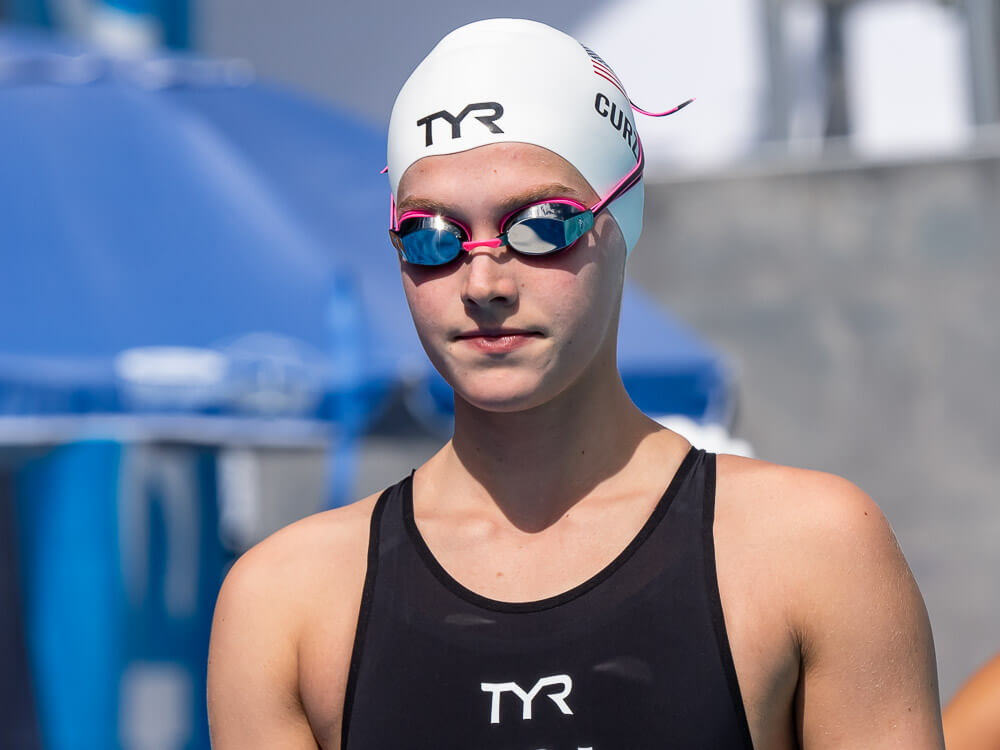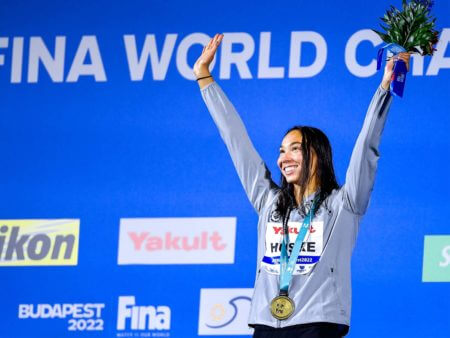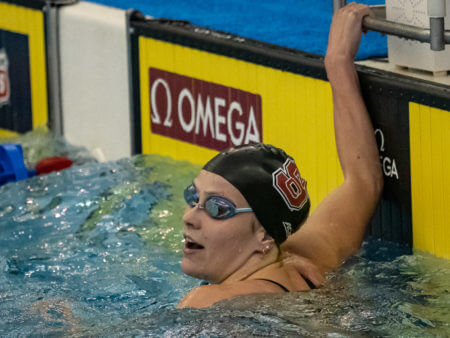100 Yards of Madness: Four-Lappers of Stroke Are Most Anticipated Races for Women’s College Season

100 Yards of Madness: Four-Lappers of Stroke Are Most Anticipated Races for Women’s College Swimming
In days, college swimming will be in full swing as all top programs yet to compete will be on the blocks for the first time this week or next week. College dual meets are a tease, a snippet of athletes racing for points and wins but not yet close to top form or even wearing racing suits in most cases. Dual meets will build toward the three focal points of the NCAA season: midseason invitationals held the week before Thanksgiving and the week after, conference championship meets in late February and early March and the national-championship meets in late March.
More than five months and hundreds of races remain before we zero in on the Division I NCAA Championships, which this year will be split between the women’s meet in Knoxville, Tenn., and the men’s in Minneapolis, Minn., but we already have certain races circled on the calendar. As we anticipate these supreme showdowns in March, each dual meet and invitational will provide a data point, a check-in for how each swimmer is faring.
Based on swimmers returning from last year and a handful of freshman added to the mix, here are a few of the women’s races we are already anticipating for the end of this college season. Coincidentally, much of the action will take place 100-yard races of the various strokes.
100 Butterfly
One season ago at the NCAA Championships, a three-swimmer showdown ended up with two swimmers going under the American record and needing every bit of that speed to get ahead of the reigning Olympic champion in the 100-meter fly. Kate Douglass won the race in 49.04, ahead of Torri Huske in 49.17 and Maggie Mac Neil in 49.18. Only Mac Neil has been quicker than those times, with the Canadian swimmer having gone 48.89 in 2021, months before she won Olympic gold.

Torri Huske won the world title in the 100-meter fly — Photo Courtesy: Andrea Staccioli / Deepbluemedia / Insidefoto
This season begins with Huske as the world’s top performer in long course after she dominated the event at the World Championships in Budapest, and she is back for her sophomore year at Stanford. Douglass returns for a fourth year at Virginia, and Mac Neil has transferred from Michigan to LSU, where she reunited with former Wolverines associate head coach Rick Bishop. It was an up-and-down spring and summer for Mac Neil, but she already swam as fast as 50.84 in a dual meet this weekend at South Carolina.
With Mac Neil and fifth-place finisher Kylee Alons both taking fifth years, the entire final from NCAAs returns this year, but the big wild card here is Claire Curzan, the swimmer who owned the American record prior to the aforementioned 2021 NCAA final. Curzan was also a finalist in the 100 fly at Worlds, and she will be in the mix here — unless she skips the event. The versatile Stanford freshman might opt to focus on other events since the Cardinal will have Huske in the 100 fly. We will be watching throughout the season and awaiting Curzan’s lineup, but the final decision will not be public until psych sheets are released two weeks out of the meet.
As for others worth watching in the 100 fly, keep an eye on Emma Sticklen, who placed fourth last year in 50.29, as well as Louisville’s Gabi Albiero, who has already posted times in the 51-low range this season after a strong summer in which she finished second in the 100-meter fly at U.S. Nationals and represented the U.S. at the Duel in the Pool.
100 Breaststroke
This event loses some experience with 2021 national champion Sophie Hansson (NC State) and two-time runnerup Alexis Wenger both moving on, but defending champion Kaitlyn Dobler returns after she came out on top of a super tight pack to win in 2022. The USC Trojan swam a time of 56.93, just four hundredths ahead of Wenger and eight hundredths faster than Hansson. Tennessee’s Mona McSharry, Texas’ Anna Elendt and Ohio State’s Hannah Bach all touched within four tenths.
The favorite going into this season is probably Elendt, who had the fastest time of the meet last year with her prelims mark of 56.87. The native of Germany then won silver in the 100-meter breast at the World Championships, just five hundredths away from gold. And the Longhorns will have a 1-2 punch in the event this season with freshman Lydia Jacoby entering the college swimming mix just one year after winning a stunning Olympic gold medal in Tokyo. Jacoby was unable to replicate her stunning 2021 success over the last year, but her ceiling remains elite.
100 Backstroke

Defending 100 back NCAA champion Katharine Berkoff — Photo Courtesy: Peter H. Bick
The 2021 NCAA final of this event saw the two fastest marks in history recorded as Katharine Berkoff became the first woman to ever break 49 with her mark of 48.74, and Gretchen Walsh nearly joined her under the barrier at 49.00. Berkoff had entered the season as a favorite after winning the NCAA title in the event one year earlier, while Walsh’s backstroke was a huge revelation in her freshman year at Virginia after she arrived in college as a sprint freestyle specialist. Both swimmers have tremendous speed and underwaters, and that allowed them to annihilate all previous records in the event.
Both Berkoff and Walsh had strong long course seasons, with Berkoff swimming the world’s fastest time in the 50-meter back and winning silver at Worlds in the event and Walsh recording a breakthrough meet at U.S. Nationals (which included her first sub-1:00 performance in the 100 back long course). Regan Smith is not returning to college swimming this year, but Stanford is sure to use Curzan in the event after she won bronze in the 100-meter back at Worlds.
Curzan ranks No. 5 in the event all-time, and her pure speed and underwater capabilities rivals Berkoff and Walsh, and a 48-second swim is well within her reach. Curzan has plenty of possibilities for her event lineup, but it’s hard to see her skipping the 100 back after her medal-winning performance at Worlds and the lack of other contending swimmers for Stanford in this event.
200 Backstroke
The second through sixth-place swimmers in this event at last year’s NCAAs all finished within six tenths of each other, and all will return in 2023. The favorite entering this year is Phoebe Bacon, who was the NCAA champion in the 200 back in 2021 and an Olympian that year before winning silver in the 200-meter back at the World Championships, coming up just four hundredths short of gold. Alabama’s Rhyan White, returning for her fifth year, joined Bacon on the podium at Worlds this summer with a bronze. Both have swum in the 1:48-range and rank among the 10 fastest performers in history.
The other key returning players in this are Cal’s Isabelle Stadden, Virginia’s Reilly Tiltmann and Virginia Tech’s Emma Atkinson, while Taylor Ruck actually owns a quicker best time than anyone else in college swimming with the 1:47.59 she swam back in 2019. And looming over this field is the possibility of Curzan, who has called the 200 back one of her favorite events, jumping into the mix. Curzan will likely have to decide between the 200 back and 100 free on the final day of NCAAs. Just like so much at last season’s NCAAs hinged on the event choices that Douglass and Alex Walsh made, Curzan’s choices are looming over the 2023 meet.
Sprint Freestyle Relays
The Virginia Cavaliers were dominant in the 200 and 400 free relays last year, with Douglass and the Walsh sisters leading the way. How could another school top that? Well, first we need to look at Alabama. The Crimson Tide fly under the radar, but they will return three swimmers who scored in both the 50 and 100 free last year, senior Cora Dupre and fifth-years Morgan Scott and Kalia Antoniou. That group finished just a half-second shy of the Cavaliers in the 200 free relay before placing third in the 400 free relay. Can this relatively-unheralded bunch get just a little bit better this year and put a scare into UVA?
As for the 400 free relay, the biggest threat comes from a school featuring the two fastest Americans in the 100-meter free in 2022. That is Stanford, with Huske returning and Curzan added to the mix, and also back is Ruck, who helped Canada to a silver medal in the 400 free relay at Worlds. Virginia won the 400 free relay by two seconds last season, but let’s see if Huske, Curzan, Ruck and Lillie Nordmann can post times throughout the season that foreshadow an epic showdown in the final event of the meet in March.



